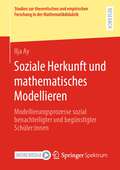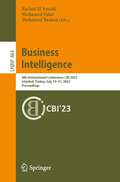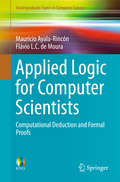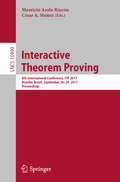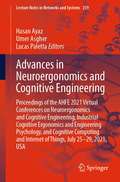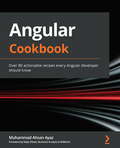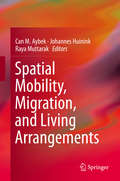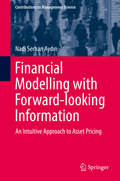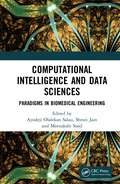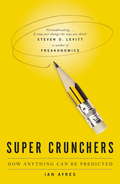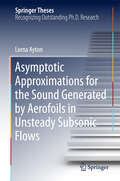- Table View
- List View
Soziale Herkunft und mathematisches Modellieren: Modellierungsprozesse sozial benachteiligter und begünstigter Schüler:innen (Studien zur theoretischen und empirischen Forschung in der Mathematikdidaktik)
by Ilja AySoziale Ungleichheit im Bildungswesen stellt eine wesentliche Herausforderung moderner Gesellschaften dar. Zusammenhänge zwischen der sozialen Herkunft von Schüler:innen und ihrer Mathematikleistung können statistisch vielfach nachgewiesen werden. Ebenso legen zahlreiche Studien nahe, dass das System Schule dazu tendiert, die außerschulischen Handlungslogiken sozial benachteiligter Personen als defizitärer einzustufen. Gerade beim Umgang mit Modellierungsaufgaben, d.h. realitätsnahen und offenen Problemen, können die außerschulischen Logiken von Schüler:innen wirksam werden. Die Bedeutung mathematischen Modellierens für soziale Ungleichheit wird dabei in der Literatur kontrovers diskutiert. Diese qualitativ angelegte Forschungsstudie untersucht auf Grundlage von Bourdieus Konzepten Mechanismen sozialer Ungleichheit beim Modellieren aus einer bildungssoziologischen Perspektive, die die Verfügbarkeit von Ressourcen und die häusliche Sozialisation von Schüler:innen in den Blick nimmt. Diskutiert werden Auffälligkeiten, die sich beim Bearbeiten von Modellierungsaufgaben bei Schüler:innen unterschiedlicher sozialer Herkunft zeigen. Damit soll insgesamt ein Beitrag dazu geleistet werden, Herausforderungen und Potentiale mathematischen Modellierens für einen sozial gerechteren Unterricht zu diskutieren.
Information Geometry and Its Applications: On The Occasion Of Shun-ichi Amari's 80th Birthday, Liblice, Czech Republic, June 2016 (Springer Proceedings in Mathematics & Statistics #252)
by Nihat Ay Paolo Gibilisco František MatúšThe book gathers contributions from the fourth conference on Information Geometry and its Applications, which was held on June 12–17, 2016, at Liblice Castle, Czech Republic on the occasion of Shun-ichi Amari’s 80th birthday and was organized by the Czech Academy of Sciences’ Institute of Information Theory and Automation. The conference received valuable financial support from the Max Planck Institute for Mathematics in the Sciences (Information Theory of Cognitive Systems Group), Czech Academy of Sciences’ Institute of Information Theory and Automation, and Università degli Studi di Roma Tor Vergata. The aim of the conference was to highlight recent advances in the field of information geometry and to identify new research directions. To this end, the event brought together leading experts in the field who, in invited talks and poster sessions, discussed both theoretical work and achievements in the many fields of application in which information geometry plays an essential role.
Information Geometry (Ergebnisse der Mathematik und ihrer Grenzgebiete. 3. Folge / A Series of Modern Surveys in Mathematics #64)
by Nihat Ay Jürgen Jost Hông Vân Lê Lorenz SchwachhöferThe book provides a comprehensive introduction and a novel mathematical foundation of the field of information geometry with complete proofs and detailed background material on measure theory, Riemannian geometry and Banach space theory. Parametrised measure models are defined as fundamental geometric objects, which can be both finite or infinite dimensional. Based on these models, canonical tensor fields are introduced and further studied, including the Fisher metric and the Amari-Chentsov tensor, and embeddings of statistical manifolds are investigated.This novel foundation then leads to application highlights, such as generalizations and extensions of the classical uniqueness result of Chentsov or the Cramér-Rao inequality. Additionally, several new application fields of information geometry are highlighted, for instance hierarchical and graphical models, complexity theory, population genetics, or Markov Chain Monte Carlo. The book will be of interest to mathematicians who are interested in geometry, information theory, or the foundations of statistics, to statisticians as well as to scientists interested in the mathematical foundations of complex systems.
The Medium of Contingency: An Inverse View of the Market
by Elie AyacheIn The Medium of Contingency Elie Ayache builds upon his ground-breaking book The Blank Swan, in exploring the intersection of philosophy and finance, introducing new notions of price and market. Inverting the received view, he now sees a creation of matter in both the market and its metaphysics, rather than pure speculation. Once recognized as the proper medium of contingency and disassociated from the probabilistic and statistical tools traditionally used to model it, the market can be thought as 'real', in a new sense of reality corresponding to the new sense of matter. To bring this new and original perspective, The Medium of Contingency builds on probability theory as first formalized by von Mises and Kolmogorov, and later revisited by Shafer and Vovk. It utilises the author's extensive experience in derivatives pricing technology and software, as well as his work in the philosophy of contingency and contingent claims, to propose a new philosophical interpretation of Brownian motion and of the Black-Scholes-Merton formula. Then it completes the overturning of the traditional view of the market by arguing that there should be no difference, ultimately, between an underlying asset and the derivative written on it. This book does not aim to change the market but the way we must think of it. It is the author's conviction that there can be no philosophy of the market, and consequently no thinking of it, without a philosophy of contingent claims and of derivative pricing. The book provides the missing piece, which the philosophy of probability cannot provide alone. Its scope, however, extends beyond the strict critique of financial mathematics, as it also, and perhaps most importantly, delivers the author's definitive treatment of the philosophically prominent and recently much discussed notion of contingency.
Business Intelligence: 8th International Conference, CBI 2023, Istanbul, Turkey, July 19–21, 2023, Proceedings (Lecture Notes in Business Information Processing #484)
by Rachid El Ayachi Mohamed Fakir Mohamed BaslamThis book constitutes the refereed proceedings of the 8th International Conference on Business Intelligence, CBI 2023, which held in Istanbul, Turkey, during July 19–21, 2023.The 15 full papers included in this book were carefully reviewed and selected from 50 submissions. They were organized in topical sections as follows: artificial intelligence and business intelligence; and optimization and decision support.
Applied Logic for Computer Scientists: Computational Deduction and Formal Proofs (Undergraduate Topics in Computer Science)
by Mauricio Ayala-Rincón Flávio L. de MouraThis book provides an introduction to logic and mathematical induction which are the basis of any deductive computational framework. A strong mathematical foundation of the logical engines available in modern proof assistants, such as the PVS verification system, is essential for computer scientists, mathematicians and engineers to increment their capabilities to provide formal proofs of theorems and to certify the robustness of software and hardware systems. The authors present a concise overview of the necessary computational and mathematical aspects of ‘logic’, placing emphasis on both natural deduction and sequent calculus. Differences between constructive and classical logic are highlighted through several examples and exercises. Without neglecting classical aspects of computational logic, the authors also highlight the connections between logical deduction rules and proof commands in proof assistants, presenting simple examples of formalizations of the correctness of algebraic functions and algorithms in PVS. Applied Logic for Computer Scientists will not only benefit students of computer science and mathematics but also software, hardware, automation, electrical and mechatronic engineers who are interested in the application of formal methods and the related computational tools to provide mathematical certificates of the quality and accuracy of their products and technologies.
Interactive Theorem Proving: 8th International Conference, ITP 2017, Brasília, Brazil, September 26–29, 2017, Proceedings (Lecture Notes in Computer Science #10499)
by Mauricio Ayala-Rincón César A. MuñozThis book constitutes the refereed proceedings of the 8th International Conference on Interactive Theorem Proving, ITP 2017, held in Brasilia, Brazil, in September 2017. The 28 full papers, 2 rough diamond papers, and 3 invited talk papers presented were carefully reviewed and selected from 65 submissions. The topics range from theoretical foundations to implementation aspects and applications in program verification, security and formalization of mathematical theories.
Advances in Neuroergonomics and Cognitive Engineering: Proceedings of the AHFE 2021 Virtual Conferences on Neuroergonomics and Cognitive Engineering, Industrial Cognitive Ergonomics and Engineering Psychology, and Cognitive Computing and Internet of Things, July 25-29, 2021, USA (Lecture Notes in Networks and Systems #259)
by Hasan Ayaz Umer Asgher Lucas PalettaThis book offers a broad overview of the field of cognitive engineering and neuroergonomics, covering emerging practices and future trends toward the harmonious integration of human operators and computational systems. It gathers both theoretical and practice-oriented studies on mental workload and stress, activity theory, human reliability, error and risk. It covers applications in various field, and corresponding strategies to make assistive technologies more user-oriented. Further, the book describes key advances in our understanding of cognitive processes, including mechanisms of perception, memory, reasoning, and motor response, with a particular focus on their role in interactions between humans and other elements of computer-based systems. Gathering the proceedings of the AHFE 2021 Conferences on Neuroergonomics and Cognitive Engineering, Industrial Cognitive Ergonomics and Engineering Psychology, and Cognitive Computing and Internet of Things, held virtually on July 25-29, 2021, from USA, this book offers extensive information and a thought-provoking guide for researchers and practitioners in cognitive engineering, neuroergonomics and their applications.
Angular Cookbook: Over 90 Recipes To Develop Your Enterprise-scale Angular Web Development Skills
by Muhammad Ahsan Ayaz Najla ObaidOver 80 actionable recipes every Angular developer should know
Spatial Mobility, Migration, and Living Arrangements
by Can M. Aybek Johannes Huinink Raya MuttarakThis book brings together ten original empirical works focusing on the influence of various types of spatial mobility – be it international or national– on partnership, family and work life. The contributions cover a range of important topics which focus on understanding how spatial mobility is related to familial relationships and life course transitions. The volume offers new insights by bringing together the state of the art in theoretical and empirical approaches from spatial mobility and international migration research. This includes, for example, studies that investigate the relationships between international migration and changing patterns of partnership choice, family formation and fertility. Complementing to this, this volume presents new empirical studies on job-related residential mobility and its impact on the relationship quality of couples, family life, and union dissolution. It also highlights the importance of research that looks at the reciprocal relationships between mobility and life course events such as young adults leaving the parental home in international migration context, re-arrangements of family life after divorce and spatial mobility of the elderly following life transitions. The scholarly work included in this volume does not only contribute to theoretical debates but also provide timely empirical evidence from various societies which represent the common features in the dynamics of spatial mobility and migration.
Al-Kashi's Miftah al-Hisab, Volume II: Translation and Commentary
by Nuh Aydin Lakhdar Hammoudi Ghada BakboukJamshīd al-Kāshī’s Miftāḥ al-Ḥisab (Key to Arithmetic) was largely unknown to researchers until the mid-20th century, and has not been translated to English until now. This is the second book in a multi-volume set that finally brings al-Kāshī’s groundbreaking textbook to English audiences in its entirety. As soon as it was studied by modern researchers, it changed some false assumptions about the history of certain topics in mathematics. Written as a textbook for students of mathematics, astronomy, accounting, engineering, and architecture, Miftah covers a wide range of topics in arithmetic, geometry, and algebra. By sharing al-Kāshī’s most comprehensive work with a wider audience, this book will help establish a more complete history of mathematics, and extend al-Kāshī’s influence into the 21st century and beyond. The book opens by briefly recounting al-Kāshī’s biography, so as to situate readers in the work’s rich historical context. His impressive status in the kingdom of Ulugh Beg is detailed, as well as his contributions to both mathematics and astronomy. As a master calculator and astronomer, al-Kāshī’s calculations of 2π and sin(1⁰) were by far the most accurate for almost two centuries. His law of cosines is still studied in schools today. This translation contributes to the understanding and appreciation of al-Kāshī’s esteemed place in the scientific world. A side-by-side presentation of the source manuscript—one of the oldest known copies—and the English translation is provided on each page. Detailed footnotes are also provided throughout, which will offer readers an even deeper look at the text’s mathematical and historical basis. Researchers and students of the history of mathematics will find this volume indispensable in filling in a frequently overlooked time period and region. This volume will also provide anybody interested in the history of Islamic culture with an insightful look at one of the mathematical world’s most neglected figures.
Al-Kashi's Miftah al-Hisab, Volume III: Translation and Commentary
by Nuh Aydin Lakhdar Hammoudi Ghada BakboukJamshīd al-Kāshī’s Miftāḥ al-Ḥisab (Key to Arithmetic) was largely unknown to researchers until the mid-20th century, and has not been translated to English until now. This is the third and final book in a multi-volume set that finally brings al-Kāshī’s groundbreaking textbook to English audiences in its entirety. As soon as it was studied by modern researchers, Miftah changed some false assumptions about the history of certain topics in mathematics. Written as a textbook for students of mathematics, astronomy, accounting, engineering, and architecture, Miftah covers a wide range of topics in arithmetic, geometry, and algebra. By sharing al-Kāshī’s most comprehensive work with a wider audience, this book will help establish a more complete history of mathematics, and extend al-Kāshī’s influence into the 21st century and beyond. The book opens by briefly recounting al-Kāshī’s biography, so as to situate readers in the work’s rich historical context. His impressive status in the kingdom of Ulugh Beg is detailed, as well as his contributions to both mathematics and astronomy. As a master calculator and astronomer, al-Kāshī’s calculations of 2π and sin(1⁰) were by far the most accurate for almost two centuries. His law of cosines is still studied in schools today. This translation contributes to the understanding and appreciation of al-Kāshī’s esteemed place in the scientific world. A side-by-side presentation of the source manuscript—one of the oldest known copies—and the English translation is provided on each page. Detailed footnotes are also provided throughout, which will offer readers an even deeper look at the text’s mathematical and historical basis. Researchers and students of the history of mathematics will find this volume indispensable in filling in a frequently overlooked time period and region. This volume will also provide anybody interested in the history of Islamic culture with an insightful look at one of the mathematical world’s most neglected figures.
Information Theory, Combinatorics, and Search Theory: In Memory of Rudolf Ahlswede (Lecture Notes in Computer Science #7777)
by Harout Aydinian Ferdinando Cicalese Christian DeppeThis volume is dedicated to the memory of Rudolf Ahlswede, who passed away in December 2010. The Festschrift contains 36 thoroughly refereed research papers from a memorial symposium, which took place in July 2011. The four macro-topics of this workshop: theory of games and strategic planning; combinatorial group testing and database mining; computational biology and string matching; information coding and spreading and patrolling on networks; provide a comprehensive picture of the vision Rudolf Ahlswede put forward of a broad and systematic theory of search.
Financial Modelling with Forward-looking Information: An Intuitive Approach to Asset Pricing (Contributions to Management Science)
by Nadi Serhan AydınThis book focuses on modelling financial information flows and information-based asset pricing framework. After introducing the fundamental properties of the framework, it presents a short information-theoretic perspective with a view to quantifying the information content of financial signals, and links the present framework with the literature on asymmetric information and market microstructure by means of a dynamic, bipartite, heterogeneous agent network. Numerical and explicit analyses shed light on the effects of differential information and information acquisition on the allocation of profit and loss as well as the pace of fundamental price discovery. The dynamic programming method is used to seek an optimal strategy for utilizing superior information. Lastly, the book features an implementation of the present framework using real-world financial data.
Measures of Noncompactness in Metric Fixed Point Theory (Operator Theory: Advances and Applications #99)
by J.M. Ayerbe Toledano T. Dominguez Benavides G. Lopez AcedoWhat is clear and easy to grasp attracts us; complications deter David Hilbert The material presented in this volume is based on discussions conducted in peri odically held seminars by the Nonlinear Functional Analysis research group of the University of Seville. This book is mainly addressed to those working or aspiring to work in the field of measures of noncompactness and metric fixed point theory. Special em phasis is made on the results in metric fixed point theory which were derived from geometric coefficients defined by means of measures of noncompactness and on the relationships between nonlinear operators which are contractive for different measures. Several topics in these notes can be found either in texts on measures of noncompactness (see [AKPRSj, [BG]) or in books on metric fixed point theory (see [GK1], [Sm], [Z]). Many other topics have come from papers where the authors of this volume have published the results of their research over the last ten years. However, as in any work of this type, an effort has been made to revise many proofs and to place many others in a correct setting. Our research was made possible by partial support of the D.G.I.C.y'T. and the Junta de Andalucia.
Introduction to Applications of Modular Forms: Computational Aspects (Synthesis Lectures on Mathematics & Statistics)
by Zafer Selcuk AyginThis book is a self-contained treatment for those who study or work on the computational aspects of classical modular forms. The author describes the theory of modular forms and its applications in number theoretic problems such as representations by quadratic forms and the determination of asymptotic formulas for Fourier coefficients of different types of special functions. A detailed account of recent applications of modular forms in number theory with a focus on using computer algorithms is provided. Computer algorithms are included for each presented application to help readers put the theory in context and make new conjectures.
Crowd Dynamics by Kinetic Theory Modeling: Complexity, Modeling, Simulations, and Safety (Synthesis Lectures on Mathematics & Statistics)
by Bouchra Aylaj Nicola Bellomo Livio Gibelli Damián KnopoffThe contents of this brief Lecture Note are devoted to modeling, simulations, and applications with the aim of proposing a unified multiscale approach accounting for the physics and the psychology of people in crowds. The modeling approach is based on the mathematical theory of active particles, with the goal of contributing to safety problems of interest for the well-being of our society, for instance, by supporting crisis management in critical situations such as sudden evacuation dynamics induced through complex venues by incidents.
Computational Intelligence and Data Sciences: Paradigms in Biomedical Engineering
by Ayodeji Olalekan Salau, Shruti Jain, Meenakshi SoodThis book presents futuristic trends in computational intelligence including algorithms as applicable to different application domains in health informatics covering bio-medical, bioinformatics, and biological sciences. Latest evolutionary approaches to solve optimization problems under biomedical engineering field are discussed. It provides conceptual framework with a focus on application of computational intelligence techniques in the domain of biomedical engineering and health informatics including real-time issues.
Super Crunchers: How Anything Can Be Predicted
by Ian AyresCompanies used to rely on human experts and their years of experience to guide them. Now, cutting-edge organizations are mining the data and crunching numbers instead, to come up with more accurate, less biased predictions. As Freakonomics detailed, statistical analysis can reveal the secret levers of causation. But economist Ian Ayres argues that that's only part of the story - super crunching is revolutionizing the way we all make decisions. Beginning with examples of the mathematician who out-predicted wine buffs in determining the best vintages, and the sports scouts who now use statistics rather than intuition to pick winners, Super Crunchers exposes the world of data-miners, introducing the people and the techniques. It illuminates the hidden patterns all around us. No businessperson, academic, student, or consumer (statistically that's everyone) should make another move without getting to grips with thinking-by-numbers - the new way to be smart, savvy and statistically superior.
Designing Big Data Platforms: How to Use, Deploy, and Maintain Big Data Systems
by Yusuf AytasDESIGNING BIG DATA PLATFORMS Provides expert guidance and valuable insights on getting the most out of Big Data systemsAn array of tools are currently available for managing and processing data—some are ready-to-go solutions that can be immediately deployed, while others require complex and time-intensive setups. With such a vast range of options, choosing the right tool to build a solution can be complicated, as can determining which tools work well with each other. Designing Big Data Platforms provides clear and authoritative guidance on the critical decisions necessary for successfully deploying, operating, and maintaining Big Data systems.This highly practical guide helps readers understand how to process large amounts of data with well-known Linux tools and database solutions, use effective techniques to collect and manage data from multiple sources, transform data into meaningful business insights, and much more. Author Yusuf Aytas, a software engineer with a vast amount of big data experience, discusses the design of the ideal Big Data platform: one that meets the needs of data analysts, data engineers, data scientists, software engineers, and a spectrum of other stakeholders across an organization. Detailed yet accessible chapters cover key topics such as stream data processing, data analytics, data science, data discovery, and data security. This real-world manual for Big Data technologies:Provides up-to-date coverage of the tools currently used in Big Data processing and managementOffers step-by-step guidance on building a data pipeline, from basic scripting to distributed systemsHighlights and explains how data is processed at scaleIncludes an introduction to the foundation of a modern data platformDesigning Big Data Platforms: How to Use, Deploy, and Maintain Big Data Systems is a must-have for all professionals working with Big Data, as well researchers and students in computer science and related fields.
Designing Big Data Platforms: How to Use, Deploy, and Maintain Big Data Systems
by Yusuf AytasDESIGNING BIG DATA PLATFORMS Provides expert guidance and valuable insights on getting the most out of Big Data systemsAn array of tools are currently available for managing and processing data—some are ready-to-go solutions that can be immediately deployed, while others require complex and time-intensive setups. With such a vast range of options, choosing the right tool to build a solution can be complicated, as can determining which tools work well with each other. Designing Big Data Platforms provides clear and authoritative guidance on the critical decisions necessary for successfully deploying, operating, and maintaining Big Data systems.This highly practical guide helps readers understand how to process large amounts of data with well-known Linux tools and database solutions, use effective techniques to collect and manage data from multiple sources, transform data into meaningful business insights, and much more. Author Yusuf Aytas, a software engineer with a vast amount of big data experience, discusses the design of the ideal Big Data platform: one that meets the needs of data analysts, data engineers, data scientists, software engineers, and a spectrum of other stakeholders across an organization. Detailed yet accessible chapters cover key topics such as stream data processing, data analytics, data science, data discovery, and data security. This real-world manual for Big Data technologies:Provides up-to-date coverage of the tools currently used in Big Data processing and managementOffers step-by-step guidance on building a data pipeline, from basic scripting to distributed systemsHighlights and explains how data is processed at scaleIncludes an introduction to the foundation of a modern data platformDesigning Big Data Platforms: How to Use, Deploy, and Maintain Big Data Systems is a must-have for all professionals working with Big Data, as well researchers and students in computer science and related fields.
Asymptotic Approximations for the Sound Generated by Aerofoils in Unsteady Subsonic Flows (Springer Theses)
by Lorna AytonThis thesis investigates the sound generated by solid bodies in steady subsonic flows with unsteady perturbations, as is typically used when determining the noise generated by turbulent interactions. The focus is predominantly on modelling the sound generated by blades within an aircraft engine, and the solutions are presented as asymptotic approximations. Key analytical techniques, such as the Wiener-Hopf method, and the matched asymptotic expansion method are clearly detailed. The results allow for the effect of variations in the steady flow or blade shape on the noise generated to be analysed much faster than when solving the problem numerically or considering it experimentally.
Jordan, Real and Lie Structures in Operator Algebras (Mathematics and Its Applications #418)
by Sh. Ayupov Abdugafur Rakhimov Shukhrat UsmanovThe theory of operator algebras acting on a Hilbert space was initiated in thirties by papers of Murray and von Neumann. In these papers they have studied the structure of algebras which later were called von Neu mann algebras or W* -algebras. They are weakly closed complex *-algebras of operators on a Hilbert space. At present the theory of von Neumann algebras is a deeply developed theory with various applications. In the framework of von Neumann algebras theory the study of fac tors (i.e. W* -algebras with trivial centres) is very important, since they are comparatively simple and investigation of general W* -algebras can be reduced to the case of factors. Therefore the theory of factors is one of the main tools in the structure theory of von Neumann algebras. In the middle of sixtieth Topping [To 1] and Stormer [S 2] have ini tiated the study of Jordan (non associative and real) analogues of von Neumann algebras - so called JW-algebras, i.e. real linear spaces of self adjoint opera.tors on a complex Hilbert space, which contain the identity operator 1. closed with respect to the Jordan (i.e. symmetrised) product INTRODUCTION 2 x 0 y = ~(Xy + yx) and closed in the weak operator topology. The structure of these algebras has happened to be close to the struc ture of von Neumann algebras and it was possible to apply ideas and meth ods similar to von Neumann algebras theory in the study of JW-algebras.
Leibniz Algebras: Structure and Classification
by Shavkat Ayupov Bakhrom Omirov Isamiddin RakhimovLeibniz Algebras: Structure and Classification is designed to introduce the reader to the theory of Leibniz algebras. Leibniz algebra is the generalization of Lie algebras. These algebras preserve a unique property of Lie algebras that the right multiplication operators are derivations. They first appeared in papers of A.M Blokh in the 1960s, under the name D-algebras, emphasizing their close relationship with derivations. The theory of D-algebras did not get as thorough an examination as it deserved immediately after its introduction. Later, the same algebras were introduced in 1993 by Jean-Louis Loday , who called them Leibniz algebras due to the identity they satisfy. The main motivation for the introduction of Leibniz algebras was to study the periodicity phenomena in algebraic K-theory. Nowadays, the theory of Leibniz algebras is one of the more actively developing areas of modern algebra. Along with (co)homological, structural and classification results on Leibniz algebras, some papers with various applications of the Leibniz algebras also appear now. However, the focus of this book is mainly on the classification problems of Leibniz algebras. Particularly, the authors propose a method of classification of a subclass of Leibniz algebras based on algebraic invariants. The method is applicable in the Lie algebras case as well. Features: Provides a systematic exposition of the theory of Leibniz algebras and recent results on Leibniz algebras Suitable for final year bachelor's students, master's students and PhD students going into research in the structural theory of finite-dimensional algebras, particularly, Lie and Leibniz algebras Covers important and more general parts of the structural theory of Leibniz algebras that are not addressed in other texts
Leibniz Algebras: Structure and Classification
by Shavkat Ayupov Bakhrom Omirov Isamiddin RakhimovLeibniz Algebras: Structure and Classification is designed to introduce the reader to the theory of Leibniz algebras. Leibniz algebra is the generalization of Lie algebras. These algebras preserve a unique property of Lie algebras that the right multiplication operators are derivations. They first appeared in papers of A.M Blokh in the 1960s, under the name D-algebras, emphasizing their close relationship with derivations. The theory of D-algebras did not get as thorough an examination as it deserved immediately after its introduction. Later, the same algebras were introduced in 1993 by Jean-Louis Loday , who called them Leibniz algebras due to the identity they satisfy. The main motivation for the introduction of Leibniz algebras was to study the periodicity phenomena in algebraic K-theory. Nowadays, the theory of Leibniz algebras is one of the more actively developing areas of modern algebra. Along with (co)homological, structural and classification results on Leibniz algebras, some papers with various applications of the Leibniz algebras also appear now. However, the focus of this book is mainly on the classification problems of Leibniz algebras. Particularly, the authors propose a method of classification of a subclass of Leibniz algebras based on algebraic invariants. The method is applicable in the Lie algebras case as well. Features: Provides a systematic exposition of the theory of Leibniz algebras and recent results on Leibniz algebras Suitable for final year bachelor's students, master's students and PhD students going into research in the structural theory of finite-dimensional algebras, particularly, Lie and Leibniz algebras Covers important and more general parts of the structural theory of Leibniz algebras that are not addressed in other texts
